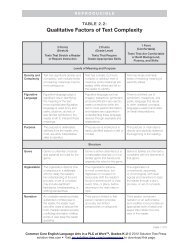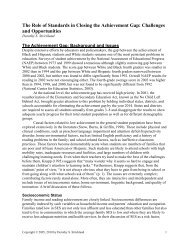Global Education Digest 2012 - International Reading Association
Global Education Digest 2012 - International Reading Association
Global Education Digest 2012 - International Reading Association
You also want an ePaper? Increase the reach of your titles
YUMPU automatically turns print PDFs into web optimized ePapers that Google loves.
SECTION 1 / Policy design and implementation of compulsory education systems<br />
accommodate the diverse learning needs of their<br />
students. As will be shown in subsequent sections,<br />
the age of school entry is also an important factor for<br />
both grade repetition and early school leaving.<br />
1.5 WHAT ARE THE MAJOR BARRIERS<br />
OR BOTTLENECKS THAT HINDER<br />
PROGRESSION THROUGH THE<br />
EDUCATION SYSTEM?<br />
By looking at major patterns in pupil progression<br />
through primary and secondary education, it is<br />
possible to identify barriers to successful learning.<br />
These key points usually include entry, grade<br />
progression, completion of a programme and<br />
transition to the next level of education.<br />
Three main patterns emerge from analysis of a<br />
range of data. The first pattern is reflected by<br />
countries with extremely high participation rates<br />
in the initial grades, which then drop sharply after<br />
Grade 1 and with each successive grade. These<br />
education systems are characterised by high<br />
numbers of late entrants (children who are older<br />
than the typical or intended primary school entry<br />
age of 6-7 years) and high rates of early school<br />
leaving, especially in early grades. As early grades<br />
provide the foundation for further learning, this<br />
means children often leave school with very little in<br />
terms of skills. At the same time, these countries<br />
often have high rates of grade repetition. The stock<br />
of pupils rapidly declines over the course of primary<br />
education, so that fewer make the transition to<br />
secondary education. This is often seen in lowincome<br />
countries, especially in sub-Saharan Africa,<br />
but also in Asia and the Pacific, as well as Latin<br />
America and the Caribbean.<br />
The second main pattern includes countries that<br />
have high gross participation rates in the initial grades<br />
of primary education (though not as high as countries<br />
in the first pattern), which is followed by a more<br />
moderate decline in participation rates. High rates of<br />
grade repetition are not uncommon, and early school<br />
leaving is a concern, especially at the secondary<br />
education level. This pattern is prevalent among<br />
middle-income countries, especially in Latin America<br />
and the Caribbean.<br />
In the third main pattern, countries have relatively<br />
consistent participation rates across grades, with<br />
little grade repetition and fairly good retention through<br />
lower secondary education. This is the largest group<br />
and includes countries from all over the world – from<br />
the highest performing systems in sub-Saharan<br />
Africa to most countries in North America and<br />
Western Europe, Latin America and the Caribbean,<br />
Central and Eastern Europe, Central Asia, and the<br />
Arab States.<br />
Overall, this section has shown that the schooling<br />
trajectory is not always smooth, nor does it deliver<br />
desired results for many children in developing<br />
countries, especially for those coming from<br />
disadvantaged backgrounds. The next sections<br />
assess the magnitude of these barriers to learning,<br />
while highlighting the compounding effects of socioeconomic<br />
disadvantages on progression patterns<br />
of students. Poor children tend to enter school late,<br />
repeat grades and are more likely to leave school<br />
early or without requisite skills. Notably, the odds are<br />
stacked against them from the beginning – meaning<br />
that without early identification and intervention, it<br />
becomes more difficult and costly to influence their<br />
trajectory for the better.<br />
16

















